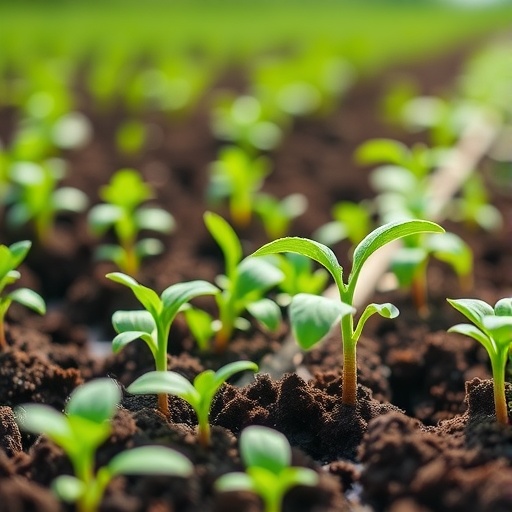In the quest for sustainable agriculture and climate-friendly industrial processes, ammonia production stands as a critical challenge. Ammonia, the foundation of most fertilizers that sustain global food production, has traditionally been synthesized through the Haber-Bosch process, an energy-hungry method reliant on fossil fuels and methane gas. Now, a breakthrough led by Prof. Nikolay Kornienko at the University of Bonn presents an electrically driven alternative that harnesses water directly as a hydrogen source, offering a pathway toward green ammonia synthesis powered by renewable energy.
Since its invention in the early 20th century by Fritz Haber and Carl Bosch, the Haber-Bosch process has revolutionized agriculture by enabling large-scale nitrogen fixation—converting abundant atmospheric nitrogen into ammonia. This chemical transformation requires high pressures, sometimes exceeding 150 bar, and temperatures up to 500 degrees Celsius, demanding massive amounts of energy, predominantly from natural gas. This heavy energy footprint entails significant carbon dioxide emissions, making ammonia production one of the largest industrial contributors to greenhouse gases worldwide.
Prof. Kornienko’s team is tackling this issue by redesigning the molecular mechanism underlying ammonia synthesis. Their approach revolves around the lithium-mediated nitrogen reduction reaction (LiNRR), a process where lithium ions are electrochemically reduced to metallic lithium which then reacts with nitrogen gas to form lithium-nitrogen intermediates. These intermediates, upon encountering a hydrogen source, convert into ammonia and recycle lithium ions, theoretically enabling a closed-loop reaction cycle fueled solely by electricity from renewable sources like wind and solar.
However, conventional LiNRR methods face grave challenges. High cell voltages are required to deposit metallic lithium, limiting energy efficiency to roughly 25 percent. Moreover, lithium’s extreme reactivity demands strict anhydrous and oxygen-free environments, complicating the system’s scalability and practical application. A particularly persistent obstacle has been sourcing hydrogen directly from water rather than sacrificial organic solvents such as alcohols, which degrade and incur higher material costs.
In an ingenious experimental design, the team introduced a palladium foil functioning simultaneously as an electrode and a selective hydrogen membrane. Palladium’s unique catalytic properties allow it to dissociate hydrogen molecules and permit atomic hydrogen transport through its lattice, effectively decoupling the water splitting reaction from the lithium-nitrogen chemistry. On one side of the membrane lies an aqueous electrolyte where water electrolysis generates hydrogen atoms; on the other side, a dry lithium environment uses these hydrogen atoms for ammonia synthesis.
The adoption of this integrated palladium membrane reactor marks a significant leap, as it enables direct utilization of water as a sustainable hydrogen source in the LiNRR framework. Verification through sensitive techniques such as infrared spectroscopy and mass spectrometry confirmed that hydrogen atoms transferred through the membrane truly participate in ammonia formation. Using deuterium-labeled water (heavy hydrogen), the researchers detected isotopically distinct ammonia molecules, proving beyond doubt the efficacy of the membrane-mediated hydrogen transfer process.
Despite this success, Prof. Kornienko acknowledges the considerable journey remaining before industrial-scale applications become viable. Current ammonia yields remain exceedingly modest, requiring future enhancements to increase reaction rates and conversion efficiency by orders of magnitude—potentially as much as 1,000 times over present performance. Controlling electron flow precisely toward nitrogen reduction rather than parasitic reactions also remains a major focus for ongoing research.
Beyond its groundbreaking scientific implications, this research represents a paradigm shift toward decentralized ammonia production, potentially enabling fertilizer synthesis at the point of use powered by locally available clean electricity. Such technology could drastically lower the carbon footprint of fertilizer manufacturing, reduce dependence on fossil fuels, and help mitigate climate change while sustaining agricultural productivity worldwide.
The team’s innovation also prompted a patent application, reflecting its novel approach which integrates materials science, electrochemistry, and catalytic engineering. This multidisciplinary strategy epitomizes the type of cutting-edge research needed to solve complex energy and sustainability problems.
This pioneering work, published in Nature Communications, opens a promising pathway toward climate-neutral nitrogen fixation. Moving forward, efforts will center on optimizing membrane properties, scaling reactor design, and improving catalytic efficiency to accelerate the practical adoption of this exciting technology.
In the broader context, these advances underscore the power of electrochemical methods in transforming traditional chemical processes. Electrifying ammonia synthesis aligns well with global trends toward electrification of industry and utilization of intermittent renewable energy sources, contributing to a circular and sustainable chemical economy.
As researchers worldwide grapple with the urgent need to reduce industrial emissions, innovations like the integrated palladium membrane reactor exemplify the fusion of fundamental science with application-driven engineering. The future of fertilizer production—and by extension, global food security—may well hinge on these groundbreaking electrochemical approaches that harness water, electricity, and nitrogen to produce ammonia cleanly and efficiently.
Subject of Research: Not applicable
Article Title: Accelerating lithium-mediated nitrogen reduction through an integrated palladium membrane hydrogenation reactor
News Publication Date: 28-Jul-2025
Web References: http://dx.doi.org/10.1038/s41467-025-62088-z
References: Hossein Bemana, Hendrik Schumann, Morgan McKee, Senada Nozinovic, Jörg Daniels, Ralf Weisbarth, Nikolay Kornienko: Accelerating lithium-mediated nitrogen reduction through an integrated palladium membrane hydrogenation reactor, Nature Communications
Image Credits: Image: Nikolay Kornienko
Keywords: ammonia synthesis, lithium-mediated nitrogen reduction, palladium membrane, renewable energy, green hydrogen, water electrolysis, sustainable fertilizer, electrochemical catalysis, climate-neutral ammonia, nitrogen fixation




